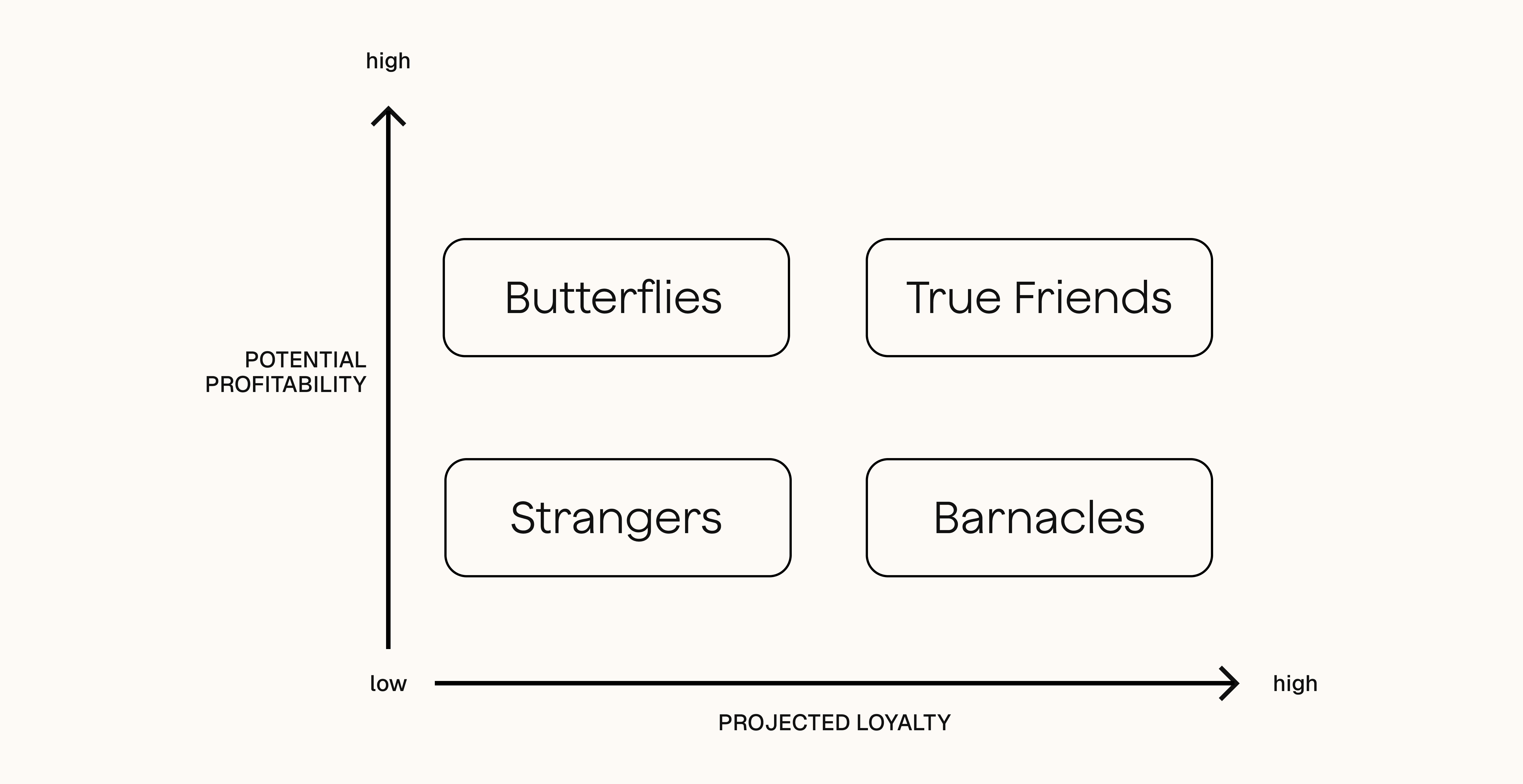
April 15, 2025
– 5 minute read
Discover the 4 types of customers - strangers, barnacles, butterflies, and true friends - and learn how to manage relationships for maximum business growth.

Cormac O’Sullivan
Author
Not all customers bring the same value. In terms of customer relationship groups, they can be categorized as strangers, barnacles, butterflies, and true friends. Each relationship group demands a different approach, not only because of their unique preferences, buying habits, and experiences, but also due to their varying potential profitability for your business. But how can you use these categories to easily segment your customers based on loyalty?
While many sources highlight customer types like impulse buyers, deal hunters, and discount shoppers, this article streamlines the classification into simpler relationship groups. We will examine four kinds of customers, ways to manage relationships with each, and strategies to avoid when engaging them.
What are the 4 Types of Customer?

Before determining how to manage customer relationships or approach specific customer groups, it’s crucial to view each relationship as an investment. Building customer loyalty is challenging, requiring consistent investment in customer relationships. Your relationship management strategy should be tailored to each customer group or segment.
Strangers
A stranger doesn’t automatically signal trouble, so don’t rush to judgment. Generally, these “strangers” are customers with low expected loyalty and limited profitability. They don’t shop often and their lifetime value is modest. Why is that the case? Good question. Often, it’s not immediately obvious why someone falls into this category.
What should you do? That depends on the kind of stranger. Some remain strangers simply because they’re not interested in a deeper connection with your brand. In these situations, it’s often better to let them go. Loving your brand and believing you can sell to anyone is admirable, but managing customer relationships wisely means knowing when to pick your battles.
A stranger could be either a disengaged long-term customer or a new one. If they’re new, identifying them is key. In these cases, delivering an exceptional customer experience may be your best shot at engagement.
Butterflies
Things are starting to look brighter. For many, particularly in the finance sector, butterflies are often viewed as the ideal customers. Why is that? They’re easy to maintain and, while they may not become brand advocates, they tend to spend considerably more on your products than other customer groups.
But does that make them your very best customers? Not exactly. Even though they generate substantial revenue and have low retention costs because they purchase infrequently, they miss a key quality perhaps the most valuable trait a customer can offer: loyalty and the ability to build customer-based brand equity.
Don’t get us wrong butterflies are fantastic. Yet, they fall short of becoming true friends who advocate for your brand and drive new customer acquisition.
Can you convert them? Possibly. Much of the outcome depends on your approach. A tailored relationship management strategy is essential. Ideally, you have some customer data any insights can be valuable. Look into their buying patterns or special occasions such as loyalty milestones, birthdays, or holidays like Valentine’s Day.
Although butterflies offer more potential than strangers, a note of caution is needed their expected loyalty remains relatively low. Avoid overspending on excessive incentives. While their revenue and profitability justify more attention than strangers, don’t be misled into chasing unrealistic expectations.
True Friends
You’ve reached the ultimate goal of customer loyalty. You’ve created fans who love and value your brand as much as you do. So, are you done now? Not quite. These customers, your true friends should be your primary source of inspiration.
Start by analyzing this group in depth. Identify the traits they share. What characteristics do they have in common? Which marketing strategies or campaigns have resonated most with them? What rewards, loyalty programs, or products have they experienced that butterflies, barnacles, or strangers haven’t?
Even then, the work isn’t over. While these customers have the highest projected loyalty and satisfaction, that doesn’t mean you’ve unlocked their full potential. Ask yourself how they can deliver even greater value to your business.
You might immediately think of increasing sales and revenue and you’d be right but it’s about achieving these outcomes differently. Keep selling to your true friends, of course, but remember they’re more than just customers. Their real value lies in loyalty. Why does this matter? Loyalty drives referrals, positive word of mouth, and brand advocacy powerful tools for sustainable growth.
That said, don’t rely on it alone; encourage it. Reward your true friends for referrals, social engagement, and other actions that expand your brand’s reach without the need for traditional marketing campaigns.
Barnacles
Barnacles are customers who show strong loyalty but deliver low profitability. They remain with your brand for a long time, make repeat purchases, and seem devoted, yet their spending rarely justifies the cost of maintaining the relationship.
Why does this happen? Often, these customers have limited budgets, buy mainly discounted items, or require more service than the revenue they provide. On the surface, their loyalty may seem valuable, but over time, their continued presence can quietly drain your resources.
So, what can you do? Start by assessing whether there’s any opportunity to increase their value. Can you upsell or cross-sell? Could you guide them toward higher-margin products or reduce the service cost needed to support them?
If that’s not feasible, it may be time to shift your focus elsewhere. Even if you value their loyalty, it’s essential to concentrate on customers who can truly drive business growth. Keep in mind: long-term loyalty doesn’t always equal long-term value.
Conclusion
This model should never be used to justify poor customer service for "low-value" customers or to focus solely on the high-spending "cash cows" of the customer base. Instead, it offers a relationship management strategy designed to prioritize investments in customer relationships, marketing activities, and more. It serves as a framework to guide how customer groups should be segmented on a broader level. Categorizing customers into these four key customer relationship groups and then further segmenting within those groups is a far more strategic approach than immediately segmenting based solely on customer lifetime value or potential profitability.



